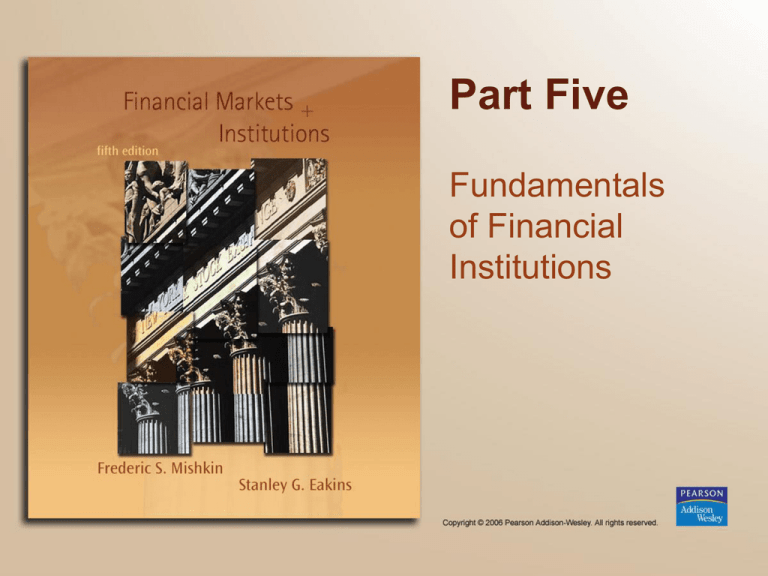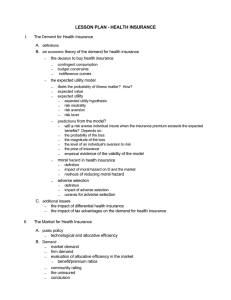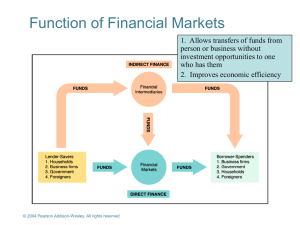
Part Five
Fundamentals
of Financial
Institutions
Chapter 15
Why Do Financial
Institutions Exist?
Chapter Preview
• We examine the differences between fixed and
managed exchange rate systems. We also
look at the controversial role of capital controls
and the IMF in the international setting.
Topics include:
– Basic Facts About Financial Structure Throughout
the World
– Transaction Costs
– Asymmetric Information: Adverse Selection and
Moral Hazard
Copyright © 2006 Pearson Addison-Wesley. All rights reserved.
15-3
Chapter Preview (cont.)
– The Lemons Problem: How Adverse Selection
Influences Financial Structure
– How Moral Hazard Affects the Choice Between
Debt and Equity Contracts
– How Moral Hazard Influences Financial
Structure in Debt Markets
– Financial Crises and Aggregate
Economy Activity
Copyright © 2006 Pearson Addison-Wesley. All rights reserved.
15-4
Basic Facts About Financial
Structure Throughout the World
• The financial system is a complex structure
including many different financial
institutions: banks, insurance companies,
mutual funds, stock and bonds
markets, etc.
• The chart on the next slide indicates how
American businesses finance their activities
with external funds.
Copyright © 2006 Pearson Addison-Wesley. All rights reserved.
15-5
Sources of External Finance in U.S.
Figure 15.1 Sources of External Funds
for Nonfinancial Businesses in the United States
Copyright © 2006 Pearson Addison-Wesley. All rights reserved.
15-6
Basic Facts About Financial
Structure Throughout the World
• The chart on the next slide how
nonfinancial business attain external
funding in the U.S., Germany, Japan, and
Canada. Notice that, although many
aspects of these countries are quite
different, the sources of financing are
somewhat consistent, with the U.S. being
different in its focus on debt.
Copyright © 2006 Pearson Addison-Wesley. All rights reserved.
15-7
Sources of Foreign External Finance
Figure 15.2 Sources of External Funds for Nonfinancial Businesses:
A Comparison of the United States with Germany, Japan, and Canada
Copyright © 2006 Pearson Addison-Wesley. All rights reserved.
15-8
Facts of Financial Structure
1. Stocks are not the most important source
of external financing for businesses.
2. Issuing marketable debt and equity
securities is not the primary way in which
businesses finance their operations.
Copyright © 2006 Pearson Addison-Wesley. All rights reserved.
15-9
Facts of Financial Structure
3. Indirect finance, which involves the activities of
financial intermediaries, is many times more
important than direct finance, in which
businesses raise funds directly from lenders in
financial markets.
4. Financial intermediaries, particularly banks, are
the most important source of external funds
used to finance businesses.
Copyright © 2006 Pearson Addison-Wesley. All rights reserved.
15-10
Facts of Financial Structure
5. The financial system is among the most
heavily regulated sectors of economy.
6. Only large, well-established corporations
have easy access to securities markets to
finance their activities.
Copyright © 2006 Pearson Addison-Wesley. All rights reserved.
15-11
Facts of Financial Structure
7. Collateral is a prevalent feature of debt
contracts for both households
and businesses.
8. Debt contracts are typically extremely
complicated legal documents that place
substantial restrictions on the behavior of
the borrowers.
Copyright © 2006 Pearson Addison-Wesley. All rights reserved.
15-12
Transactions Costs
• Transactions costs influence financial structure
– E.g., a $5,000 investment only allows you to
purchase 100 shares @ $50 / share (equity)
– No diversification
– Bonds even worse—most have a $1,000 size
• In sum, transactions costs can hinder
flow of funds to people with productive
investment opportunities
Copyright © 2006 Pearson Addison-Wesley. All rights reserved.
15-13
Transactions Costs
• Financial intermediaries make profits by
reducing transactions costs
1. Take advantage of economies of scale
(example: mutual funds)
2. Develop expertise to lower
transactions costs
• Also provides investors with liquidity, which
explains Fact # 3 (slide 15-10)
Copyright © 2006 Pearson Addison-Wesley. All rights reserved.
15-14
Asymmetric Information: Adverse
Selection and Moral Hazard
• In your introductory finance course, you
probably assumed a world of symmetric
information—the case where all parties to a
transaction or contract have the same
information, be that little or a lot
• In many situations, this is not the case. We
refer to this as asymmetric information.
Copyright © 2006 Pearson Addison-Wesley. All rights reserved.
15-15
Asymmetric Information: Adverse
Selection and Moral Hazard
• Asymmetric information can take on many
forms, and is quite complicated. However,
to begin to understand the implications of
asymmetric information, we will focus on
two specific forms:
– Adverse selection
– Moral hazard
Copyright © 2006 Pearson Addison-Wesley. All rights reserved.
15-16
Asymmetric Information: Adverse
Selection and Moral Hazard
• Adverse Selection
1. Occurs when one party in a transaction has
better information than the other party
2. Before transaction occurs
3. Potential borrowers most likely to produce
adverse outcome are ones most likely to
seek loan and be selected
Copyright © 2006 Pearson Addison-Wesley. All rights reserved.
15-17
Asymmetric Information: Adverse
Selection and Moral Hazard
• Moral Hazard
1. Occurs when one party has an incentive to
behave differently once an agreement is
made between parties
2. After transaction occurs
3. Hazard that borrower has incentives to
engage in undesirable (immoral) activities
making it more likely that won't pay
loan back
Copyright © 2006 Pearson Addison-Wesley. All rights reserved.
15-18
Asymmetric Information: Adverse
Selection and Moral Hazard
• The analysis of how asymmetric
information problems affect behavior is
known as agency theory.
• We will now use these ideas of adverse
selection and moral hazard to explain how
they influence financial structure.
Copyright © 2006 Pearson Addison-Wesley. All rights reserved.
15-19
The Lemons Problem: How Adverse
Selection Influences Financial Structure
•
Lemons Problem in Securities Markets
1. If can't distinguish between good and bad
securities, willing pay only average of good
and bad securities’ value
2. Result: Good securities undervalued and
firms won't issue them; bad securities
overvalued so too many issued
Copyright © 2006 Pearson Addison-Wesley. All rights reserved.
15-20
The Lemons Problem: How Adverse
Selection Influences Financial Structure
•
Lemons Problem in Securities Markets
3. Investors won't want buy bad securities, so
market won't function well
–
Explains Fact # 1 and # 2 (slide 15-9)
–
Also explains Fact # 6 (slide 15-11): Less
asymmetric info for well known firms, so
smaller lemons problem
Copyright © 2006 Pearson Addison-Wesley. All rights reserved.
15-21
Tools to Help Solve Adverse
Selection (Lemons) Problems
1. Private Production and Sale of Information
– Free-rider problem interferes with this solution
2. Government Regulation to Increase Information
(explains Fact # 5, slide 15-11)
– For example, annual audits of public corporations
– Does not eliminate the problem
Copyright © 2006 Pearson Addison-Wesley. All rights reserved.
15-22
Tools to Help Solve Adverse
Selection (Lemons) Problems
3. Financial Intermediation
– Analogy to solution to lemons problem
provided by used car dealers
– Avoid free-rider problem by making private
loans (explains Fact # 3 and # 4,
slide 15-10)
4. Collateral and Net Worth
– Explains Fact # 7, slide 15-12
Copyright © 2006 Pearson Addison-Wesley. All rights reserved.
15-23
How Moral Hazard Affects the Choice
Between Debt and Equity Contracts
•
Moral Hazard in Equity Contracts:
the Principal-Agent Problem
1. Result of separation of ownership by
stockholders (principals) from control by
managers (agents)
2. Managers act in own rather than
stockholders' interest
Copyright © 2006 Pearson Addison-Wesley. All rights reserved.
15-24
How Moral Hazard Affects the Choice
Between Debt and Equity Contracts
• Tolls to Help Solve the Principal-Agent Problem
1.Production of Information: Monitoring
2.Government Regulation to Increase Information
3.Financial Intermediation (e.g, venture capital)
4.Debt Contracts
• Explains Fact # 1, slide 15-9: Why debt is used
more than equity
Copyright © 2006 Pearson Addison-Wesley. All rights reserved.
15-25
How Moral Hazard Influences
Financial Structure in Debt Markets
• Because of the design of debt contacts,
borrowers only pay a fixed amount and keep any
cash flow above this amount. In some
circumstances, this creates an incentive for
borrowers to take on riskier projects.
• For example, if a firm owes $100 but only has
$90, it will be bankrupt. The firm “has nothing to
lose” by looking for “risky” projects to raise the
needed cash.
Copyright © 2006 Pearson Addison-Wesley. All rights reserved.
15-26
How Moral Hazard Influences
Financial Structure in Debt Markets
• Tools to Help Solve Moral Hazard in
Debt Contracts
1. Net Worth
2. Monitoring and Enforcement of
Restrictive Covenants
3. Financial Intermediation—banks and other
intermediaries have special advantages
in monitoring
• Explains Facts # 1–4, slides 15-9 & 15-10
Copyright © 2006 Pearson Addison-Wesley. All rights reserved.
15-27
Asymmetric Information Problems
and Tools to Solve Them
Copyright © 2006 Pearson Addison-Wesley. All rights reserved.
15-28
Case: Financial Development
and Economic Growth
• “Financial repression” (in Developing & Ex-Comm.
Countries) leads to low growth
• Why?
1.
2.
3.
4.
5.
Poor legal system
Weak accounting standards
Government directs credit
Financial institutions nationalized
Inadequate government regulation
• Financial Crises
Copyright © 2006 Pearson Addison-Wesley. All rights reserved.
15-29
Financial Crises and Aggregate
Economic Activity
Our analysis of the affects of adverse
selection and moral hazard can also assist
us in understanding financial crises, major
disruptions in financial markets. Then end
result of most financial crises in the inability
of markets to channel funds from savers to
productive investment opportunities.
Copyright © 2006 Pearson Addison-Wesley. All rights reserved.
15-30
Financial Crises and Aggregate
Economic Activity
• Factors Causing Financial Crises
1. Increases in Interest Rates
2. Increases in Uncertainty
3. Asset Market Effects on Balance Sheets
•
Stock market effects on net worth
•
Unanticipated deflation
•
Cash flow effects
Copyright © 2006 Pearson Addison-Wesley. All rights reserved.
15-31
Financial Crises and Aggregate
Economic Activity
•
Factors Causing Financial Crises
4. Bank Panics
5. Government Fiscal Imbalances
•
As shown in the next slide, most U.S.
financial crises have begun with a
deterioration in banks’ balance sheets.
Copyright © 2006 Pearson Addison-Wesley. All rights reserved.
15-32
Figure 15.3 Sequence of Events
in U.S. Financial Crises
Case: Financial Crises in Emerging Market
Countries: Mexico, East Asia, and Argentina
• The three countries show how a country
can shift from a path of high growth just
before a financial crises.
• An important factor was the deterioration in
banks’ balance sheets due to increasing
loan loses.
Copyright © 2006 Pearson Addison-Wesley. All rights reserved.
15-34
Figure 15.4 Sequence of Events in Mex.,
Arg. and E. Asian Crises
Chapter Summary
• Basic Facts About Financial Structure
Throughout the World: we reviewed eight
basic facts concerning the structure of the
financial system
• Transaction Costs: we examined how
transaction costs can hinder capital flow
and the role financial institutions play in
reducing transaction costs
Copyright © 2006 Pearson Addison-Wesley. All rights reserved.
15-36
Chapter Summary (cont.)
• Asymmetric Information: Adverse Selection and
Moral Hazard: we defined asymmetric information
along with two categories of asymmetric
information—adverse selection and moral hazard
• The Lemons Problem: How Adverse Selection
Influences Financial Structure: we discussed how
adverse selection effects the flow of capital and
tools to reduce this problem
Copyright © 2006 Pearson Addison-Wesley. All rights reserved.
15-37
Chapter Summary (cont.)
• How Moral Hazard Affects the Choice Between
Debt and Equity Contracts: we reviewed the
principal-agent problem and how moral hazard
influences the use of more debt than equity
• How Moral Hazard Influences Financial Structure
in Debt Markets: we discussed how moral hazard
and debt may lead to increased risk-taking, and
tools to reduce this problem
Copyright © 2006 Pearson Addison-Wesley. All rights reserved.
15-38
Chapter Summary (cont.)
• Financial Crises and Aggregate Economy
Activity: we discussed how adverse
selection and moral hazard influence
financial crises, and showed examples from
both the U.S. and abroad
Copyright © 2006 Pearson Addison-Wesley. All rights reserved.
15-39








